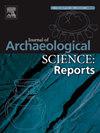干燥土壤条件下墓葬中木材和其他植物遗骸的研究潜力:保加利亚案例研究
IF 1.5
2区 历史学
0 ARCHAEOLOGY
引用次数: 0
摘要
对于标准的考古植物学研究而言,土壤条件以干燥为主的地区的墓葬环境往往具有挑战性。虽然植物遗骸可以保存在干燥、缺氧(干燥)或存在金属物体及其腐蚀产物(矿化)的结构中,但它们往往被忽视,研究也被忽视。本文通过对现代保加利亚境内 30 个古代墓穴的案例研究,说明对非炭化机制保存的植物遗骸进行取样和分析的可能性和局限性。在植物遗骸中,木材是最常见的发现,在墓葬结构中用作建筑材料、棺木或属于墓穴中放置的不同墓葬祭品--大多是武器或其他木制物品的部件。在某些情况下,我们还发现了水果(杏仁、榛子)、蔷薇等花卉以及植物纤维/纺织品。通过这一概述,我们希望提高人们对这一经常被忽视的丰富信息来源的认识,并强烈建议对此类有机物质进行更仔细的取样和记录。因此,本文举例说明了获取有关植物及其产品在古代墓葬习俗中的作用以及与这些发现相关的沉积条件等丰富信息的策略。本文章由计算机程序翻译,如有差异,请以英文原文为准。
The research potential of wood and other plant remains in burial contexts with dry soil conditions: Case studies from Bulgaria
Burial context in regions with predominantly dry soil conditions are often challenging for standard archaeobotanical studies. Although plant remains can be preserved in structures with dry, anoxic conditions (desiccation) or when metal objects and their corrosion products (mineralisation) are present, they were often overlooked and their study neglected.
This paper considers case studies form 30 ancient necropoles from the territory of modern-day Bulgaria to illustrate the possibilities and limitations inherent in the sampling and analysis of plant remains that have been preserved by a mechanism other than charring. Among the plant remains wood was the most common finding in burial structures used as construction material, for coffins, or belonging to different grave offerings placed in the graves – mostly parts of armament or other wooden objects. In some cases, fruits (Amygdalus communis, Corylus avellana), flowers like Rosa sp. and plant fibres/textiles were attested. With this overview, we aim to increase awareness of this often-neglected source of abundant information, and strongly suggest more careful sampling and documentation of such organic matter. The paper thus provides examples of strategies for obtaining rich information regarding the role of plants and their products in ancient burial practices, as well as the depositional conditions related to these finds.
求助全文
通过发布文献求助,成功后即可免费获取论文全文。
去求助
来源期刊

Journal of Archaeological Science-Reports
ARCHAEOLOGY-
CiteScore
3.10
自引率
12.50%
发文量
405
期刊介绍:
Journal of Archaeological Science: Reports is aimed at archaeologists and scientists engaged with the application of scientific techniques and methodologies to all areas of archaeology. The journal focuses on the results of the application of scientific methods to archaeological problems and debates. It will provide a forum for reviews and scientific debate of issues in scientific archaeology and their impact in the wider subject. Journal of Archaeological Science: Reports will publish papers of excellent archaeological science, with regional or wider interest. This will include case studies, reviews and short papers where an established scientific technique sheds light on archaeological questions and debates.
 求助内容:
求助内容: 应助结果提醒方式:
应助结果提醒方式:


